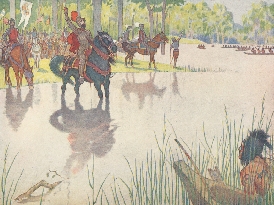Hold Your Horses
Some Native Americans living in the Southeast first saw horses when Spanish explorers came to Florida and the Carolinas in the 1500s. Most Native Americans in North America, however, did not see a horse until 1598. That was the year a band of Spanish settlers arrived in New Mexico. Among the animals they brought to New Mexico were horses.
Some Native Americans called the horse “big dog.” Others called it “sky dog.” They thought it was a monster. Still others called the horse “elk dog” because it was the same size as an elk. This confusing animal changed the way of life for many Native Americans. It changed the way they traveled, hunted, and fought.
Over time, the Native Americans watched how the Spaniards treated their animals. They learned how to care for the horses. They also learned how to ride. The Spaniards had bridles and saddles for their horses, but many Native Americans learned to ride without either. They soon became skilled riders. Warriors rode their horses in battle. They could hide themselves by slipping to one side of the animal. That way, the horse was similar to a galloping shield!

Native Americans had never seen an animal like the horse.
Hernando de Soto at the Mississippi River, 1920, E. Boyd Smith. © Corbis.
In 1680, the Pueblo revolted against the settlers in New Mexico. Many of the settlers fled. They left their animals behind. Native Americans kept some horses. Other horses ran wild. They formed herds that spread north into the Plains. Soon, other Native Americans would be riding, too.